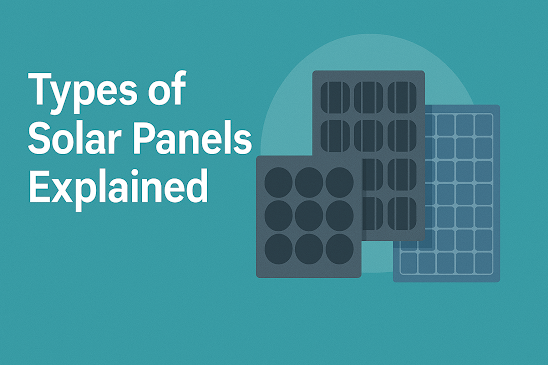Types of Solar Panels Explained
Not all solar panels are created equal. Whether you're building an off-grid setup or adding rooftop solar, it’s critical to understand the types of solar panels available — and how they impact performance, cost, and long-term savings.
☀️ Why Panel Type Matters
Panel type affects:
- ✅ Efficiency (power output per square meter)
- ✅ Price per watt
- ✅ Aesthetics (color, texture)
- ✅ Temperature performance
- ✅ Roof space requirements
🔹 Monocrystalline Panels
Also known as: Mono-Si, single-crystal panels
Efficiency: 18–22%
Color: Black
Best for: Homes with limited roof space, high-efficiency needs
Pros:
- Highest efficiency in real-world conditions
- Performs better in low light
- Longest lifespan (25+ years)
Cons:
- Most expensive per watt
- Manufacturing process wastes silicon
🔹 Polycrystalline Panels
Also known as: Poly-Si, multicrystalline
Efficiency: 15–17%
Color: Blue
Best for: Budget installations with decent roof space
Pros:
- Lower cost per watt
- Less silicon waste during manufacturing
Cons:
- Lower efficiency than mono
- Requires more space for same output
🔹 Thin-Film Panels
Types: a-Si (amorphous), CdTe (cadmium telluride), CIGS
Efficiency: 10–12%
Best for: Portable solar, large ground-mounted systems
Pros:
- Lightweight and flexible
- Low manufacturing cost
- Performs better in hot climates
Cons:
- Lower efficiency
- Shorter lifespan
- Degrades faster than crystalline panels
🔹 Bifacial Panels
What makes them special? They capture sunlight from both front and back
Efficiency: Up to 25% total with reflective mounting
Best for: Carports, raised structures, commercial roofs
Pros:
- Higher total yield per panel
- More durable with tempered glass on both sides
Cons:
- Higher cost
- Needs elevation or reflective surface to benefit
💡 Which One Should You Choose?
It depends on your needs:
- Limited space → Go Monocrystalline
- Budget system → Polycrystalline
- Mobile/portable use → Thin-Film
- High-yield custom design → Bifacial
📊 Cost per Watt Comparison
| Type | Avg Cost (USD/W) | Lifespan |
|---|---|---|
| Monocrystalline | $0.70–$1.10 | 25–30 yrs |
| Polycrystalline | $0.60–$0.90 | 20–25 yrs |
| Thin-Film | $0.45–$0.70 | 10–15 yrs |
| Bifacial | $1.00–$1.50 | 25+ yrs |
🛠️ Internal Tools & Resources
🚀 Final Thoughts
Choosing the right panel isn’t about chasing the highest efficiency — it’s about matching performance with your goals, space, and budget. Whether you’re building a small off-grid cabin or powering a full home, knowing the types of solar panels is your first step to making the smartest choice.
Use our Solar Calculator to see exactly how many panels you need based on your selected panel type, daily load, and available roof area.
